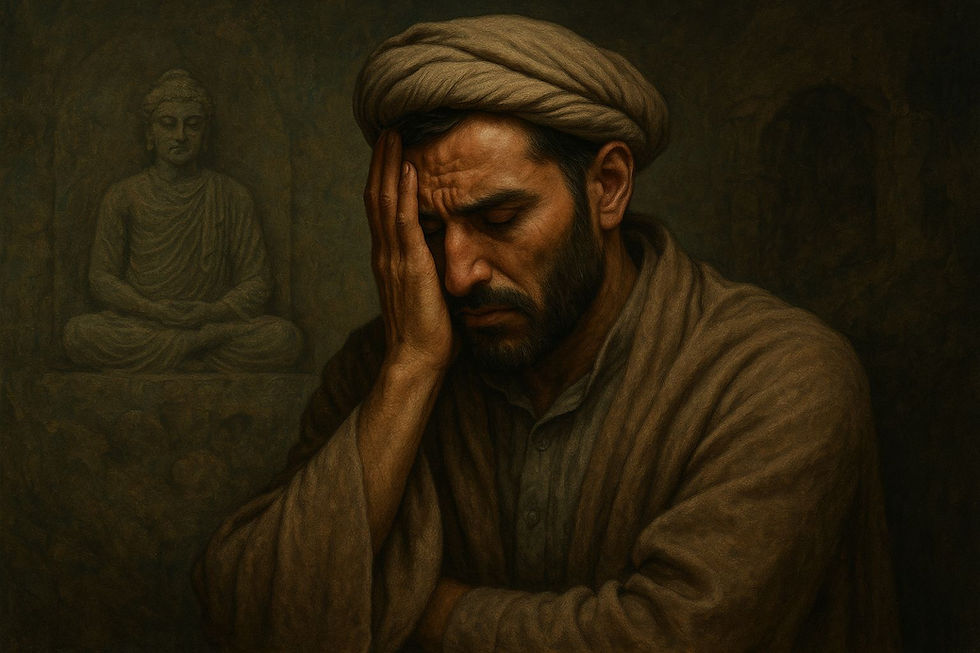Five Lies That Plundered Pashtun Identity
- Türán

- Apr 23
- 4 min read
Updated: May 13
By Assad Sharifi

There are lies so old, they no longer need to shout. They whisper. They linger. They become the dust in our breath, the ink in our books, the shape of our prayers. Those lies plundered Pashtun Identity.
This is a scroll for every Pashtun who has ever felt that the Pashtun Identity was forever lost. For every soul who looked at ruins and thought they were looking at someone else’s past. No. This is our story, the one they tried to erase with blades, with ink, with shame.
We write not solely to remember. We write to resurrect and bring to light Five Lies That Plundered Pashtun Identity
Lie One: Pashtun Identity is Iranian
False. Categorically. Politically. Spiritually. Factual. Historically. False! Pashtun identity is scared, Gandharai, it is not Iranian and never was.
Pashto does not descend from Persian. It is not a sister language. It is not even a cousin. Pashto is older in rhythm and deeper in syntax. Its roots stretch into Gāndhārī Prakrit, its body shaped by oral tradition, its breath still carrying the echoes of carved rock and spinning prayer wheels in Gandhara, the birthplace of Pashto and Pashtuns. Pashto is truly the roots of Pashtun Identity.
To label it “Iranian” was not an act of linguistic clarity. It was a colonial convenience, a cartographer’s lie stitched together by scholars who knew more about empires than about earth.
Pashto is not a branch of a Persian tree. It is the root of something older. Gandhara itself.
Lie Two: Pashtuns Were Always Warriors
This is the most dangerous lie. It has been sold to the world, packaged in turbans and blood, recycled by empires, dictators, and modern states who need Pashtuns to play the role of the eternal fighter. But before the rifle, there was the sutra. Before the jihad, there was the cave of Naranjā. Before the uniform, there was the monk’s robe.
Swat Valley alone was home to over 1,400 monasteries — centers of meditation, translation, astronomy, and inner stillness. Pashtuns sculpted the Buddha’s silence. We memorized mantras. We raised stupas with our own hands.
The warrior identity was not born from choice. It was born from survival — after the Arab invasion brutalized the land, executed our sages, enslaved our women, and replaced meditation with mimicry.
"We did not always carry swords. Once, we carried sacred scrolls."
Lie Three: Gandhara Was Indian
Gandhara was not Indian. It was Gandharan.
It stood at the meeting point of Central Asia, South Asia, and the Persian plateau. It was shaped by Greeks, Buddhists, Zoroastrians, Jains, and by the ancestors of today’s Pashtuns.
The Indian state inherited its ruins. But the bones, the dust, the syntax, and the memory of Gandhara live on in Pashto, in Pashtunwali, and in the unspoken ache carried by the people who still walk its soil.
To call Gandhara “Indian” is to deny the living descendants of its soul. It is to claim the corpse and discard the bloodline.
"Gandhara is not an exhibit. It is a mother, and her children still speak her name."
Lie Four: Islam Came Peacefully to Pashtun Lands
No. It came with fire, execution, rape, and public terror.
Mosques were not built with consent. They were built atop shattered monasteries. The call to prayer was not welcomed. It was enforced. Pashtuns did not embrace Islam. They performed it, for survival. that's why Pashtuns fear their own glorious history.
We wore the mask of belief so our children would not be killed. We memorized foreign verses while forgetting the voices of our own ancestors. And over generations, the mask fused with the skin. Trauma became theology. Fear became faith. Do not mistake the silence of memory for consent.
Lie Five: The Yogācāra School Is Indian
The school of Mind Only “Yogācāra” is taught today in global monasteries as an Indian export. But its founders, Asaṅga and Vasubandhu, were born in Gandhara. They were children of Swat, trained in the mountains and caves of Uḍḍiyāna, disciples of silence, sculptors of consciousness.
They did not emerge from Varanasi. They emerged from the same land now mislabeled as tribal and backward. The birth of “Mind-Only” thought happened in Pashtun lands. That fire of introspection was ours. It still is.
To the One Who Still Wonders...
If your name is Pashtun, then your bloodline is Gandhara. You may be a Muslim now, but you were once a monk. You were once a sculptor of stillness, a builder of stone dreams, a seeker of inner and outer harmony. This is not about leaving your faith. This is about reclaiming your memory.
NeoGandhara Is Not a Website. It Is a Return.
We write for the monks whose names were burned. We write for the girls who were sold, the caves that were bombed, the statues whose silence still haunts our dreams.
We write for you.Not to remind you.But to wake you.
Pashtun identity was never born in war. It was born in wisdom. And we are returning to it.
This is your true story. You are not lost.




Comments